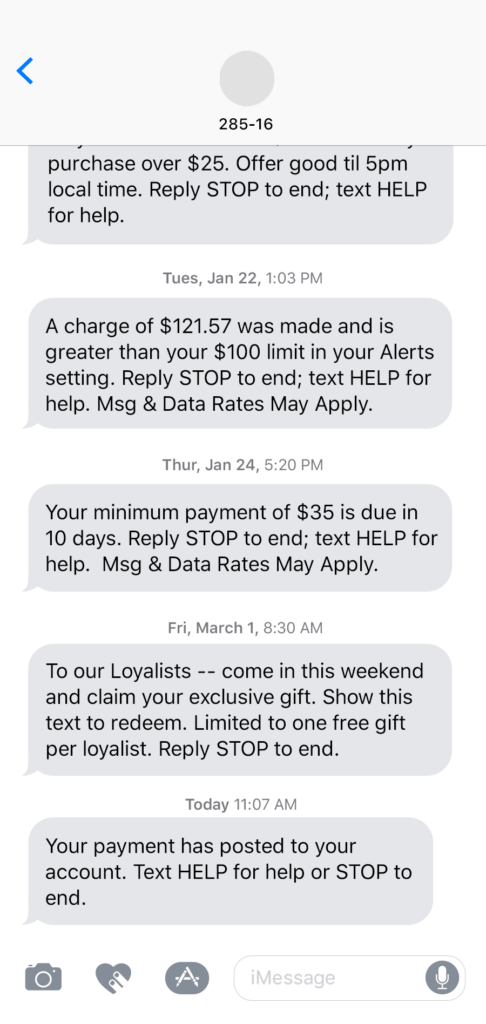
Should I Use a Shared Short Code in My SMS Marketing Strategy?

Mitzi Mori Senior Product Manager
Wondering whether you should use shared short codes (SSC) in your text marketing program? You’re not alone.
In addition to the many reasons shared short codes are not our favorite, AT&T recently announced that they are discontinuing support for shared short codes. They no longer will approve new SSC, effective immediately, and have plans to end support on existing SSC this year. We predict other carriers will make similar moves.
So if you’re in the midst of deciding whether to use a shared short code — or whether to migrate from a shared short code to a dedicated code — here are some reasons to consider avoiding them.
Shared Short Codes Are Risky, Limiting & Create Negative Customer Experiences
What is a shared short code? Shared short codes (SSC), are a special category of short codes which are used to send A2P (Application to Person) SMS, text messages from a brand to a consumer. They are called shared because they are used by more than one brand to interact with their customer base.
Using an SSC can provide cost savings because the monthly lease for a short code is split across the various brands that use it, but the savings come with risk and limitations that keep SSC from actually being cost effective.
One Bad Actor Can Shut You Down
Because you are sharing the code with other companies, their decisions on how they handle their SMS messaging can have an impact on your brand reputation, and even result in an abrupt termination of the short code by the carriers.
For example, if one brand sends a message violating the carrier’s guideline or sends content that violates compliance, the carrier can shut down the short code, affecting all brands who share that short code.
Shared Codes Can Confuse Customers
Having different brands using the same short code can be pretty confusing for the consumer. On a user’s phone, the short code will appear as one phone number but include messages from different brands. This is just bad UX that can lead to customers mixing up messages and brands.

The Keywords You Want Might Already Be Taken
For SSC, keywords are available either on a first-come-first-serve or may have to be reserved/vetted with the service provider. For example, there may be multiple brands sharing the short code who want to enroll people into a rewards program. If one brand selects JOIN as their keyword, then any other brand using that short code will have to use a different keyword for their rewards sign-up, like REWARD or NEW. Keywords can become important for attribution and segmentation, so it’s important that you choose and use the right keywords for your SMS marketing.
Keyword Confusion Can Create Unintended Opt-Outs
Did you know that when you share short codes, you’re also sharing the opt-outs? When a user texts STOP (or any other mandated stop-keywords, i.e, CANCEL, UNSUBSCRIBE, QUIT, END) the result is that the mobile number is opted-out to receive further text messages from that specific short code. This means that if each brand using the short code lost an opt-in, since the opt-status is maintained at the short code level.
Shared Codes Mean Your Brand Is Not the Main Point of Contact for SMS Support
Because the code is shared among several brands, the HELP and STOP messages cannot contain brand-specific information. Instead, content has to be generalized — and in most cases, the service provider will be the main point of contact for questions or support. This forces brands to rely on the user’s mobile service provider to deliver customer support for any technical issues. In our view, something important as customer experience should not be handed off to a company that’s not as invested in your relationship with customers as you are.
Dedicated Short Codes Reduce Risk & Create Strong Customer Experiences
So what’s a better alternative to shared short codes? Dedicated short codes. As their name indicates, dedicated short codes are SMS codes owned only by one brand and cannot be shared.
With dedicated short codes, brands can set up as many keywords as they like. The customer experience is more streamlined. It also eliminates any confusion about which brand a customer is interacting with. And there’s no risk of unintentional opt-outs, which means your SMS engagement channel is more reliable.
As an additional benefit, dedicated short codes can be made into vanity codes, a personalized code for your brand. For instance, 54657 for Kohl’s (the numbers spell out the name in the telephone keypad) and 827538 for Target. Dedicated short codes like vanity codes can help set your brand apart from others.
It’s Time to Migrate from Shared to Dedicated Short Codes
To sum up: we highly recommend migrating from SSC to dedicated short codes. For more information or any assistance in migrating from a shared to a dedicated short code, please don’t hesitate to reach out.
Want to further your SMS education? Check out these great resources on SMS marketing.
Subscribe for updates
If the form doesn't render correctly, kindly disable the ad blocker on your browser and refresh the page.
Related Posts


SMS Regulatory Compliance: What You Need to Know About Text Messaging
